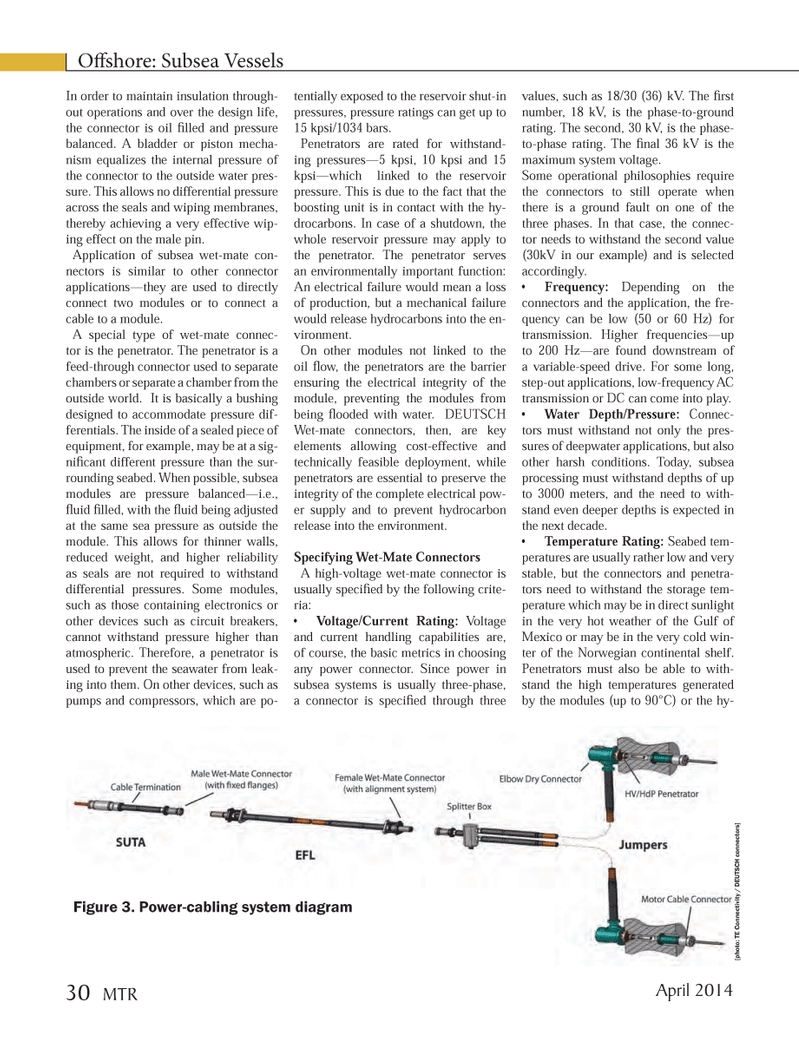
Page 30: of Marine Technology Magazine (April 2014)
Offshore Energy
Read this page in Pdf, Flash or Html5 edition of April 2014 Marine Technology Magazine
Off shore: Subsea Vessels
In order to maintain insulation through- out operations and over the design life, the connector is oil fi lled and pressure balanced. A bladder or piston mecha- nism equalizes the internal pressure of the connector to the outside water pres- sure. This allows no differential pressure across the seals and wiping membranes, thereby achieving a very effective wip- ing effect on the male pin.
Application of subsea wet-mate con- nectors is similar to other connector applications—they are used to directly connect two modules or to connect a cable to a module.
A special type of wet-mate connec- tor is the penetrator. The penetrator is a feed-through connector used to separate chambers or separate a chamber from the outside world. It is basically a bushing designed to accommodate pressure dif- ferentials. The inside of a sealed piece of equipment, for example, may be at a sig- nifi cant different pressure than the sur- rounding seabed. When possible, subsea modules are pressure balanced—i.e., fl uid fi lled, with the fl uid being adjusted at the same sea pressure as outside the module. This allows for thinner walls, reduced weight, and higher reliability as seals are not required to withstand differential pressures. Some modules, such as those containing electronics or other devices such as circuit breakers, cannot withstand pressure higher than atmospheric. Therefore, a penetrator is used to prevent the seawater from leak- ing into them. On other devices, such as pumps and compressors, which are po- tentially exposed to the reservoir shut-in pressures, pressure ratings can get up to 15 kpsi/1034 bars.
Penetrators are rated for withstand- ing pressures—5 kpsi, 10 kpsi and 15 kpsi—which linked to the reservoir pressure. This is due to the fact that the boosting unit is in contact with the hy- drocarbons. In case of a shutdown, the whole reservoir pressure may apply to the penetrator. The penetrator serves an environmentally important function:
An electrical failure would mean a loss of production, but a mechanical failure would release hydrocarbons into the en- vironment.
On other modules not linked to the oil fl ow, the penetrators are the barrier ensuring the electrical integrity of the module, preventing the modules from being fl ooded with water. DEUTSCH
Wet-mate connectors, then, are key elements allowing cost-effective and technically feasible deployment, while penetrators are essential to preserve the integrity of the complete electrical pow- er supply and to prevent hydrocarbon release into the environment.
Specifying Wet-Mate Connectors
A high-voltage wet-mate connector is usually specifi ed by the following crite- ria: • Voltage/Current Rating: Voltage and current handling capabilities are, of course, the basic metrics in choosing any power connector. Since power in subsea systems is usually three-phase, a connector is specifi ed through three values, such as 18/30 (36) kV. The fi rst number, 18 kV, is the phase-to-ground rating. The second, 30 kV, is the phase- to-phase rating. The fi nal 36 kV is the maximum system voltage.
Some operational philosophies require the connectors to still operate when there is a ground fault on one of the three phases. In that case, the connec- tor needs to withstand the second value (30kV in our example) and is selected accordingly. • Frequency: Depending on the connectors and the application, the fre- quency can be low (50 or 60 Hz) for transmission. Higher frequencies—up to 200 Hz—are found downstream of a variable-speed drive. For some long, step-out applications, low-frequency AC transmission or DC can come into play. • Water Depth/Pressure: Connec- tors must withstand not only the pres- sures of deepwater applications, but also other harsh conditions. Today, subsea processing must withstand depths of up to 3000 meters, and the need to with- stand even deeper depths is expected in the next decade. • Temperature Rating: Seabed tem- peratures are usually rather low and very stable, but the connectors and penetra- tors need to withstand the storage tem- perature which may be in direct sunlight in the very hot weather of the Gulf of
Mexico or may be in the very cold win- ter of the Norwegian continental shelf.
Penetrators must also be able to with- stand the high temperatures generated by the modules (up to 90°C) or the hy- [photo: TE Connectivity / DEUT
SCH connector s]
Figure 3. Power-cabling system diagram 30 MTR
April 2014
MTR #3 (18-33).indd 30 4/10/2014 11:58:49 AM

 29
29

 31
31
